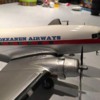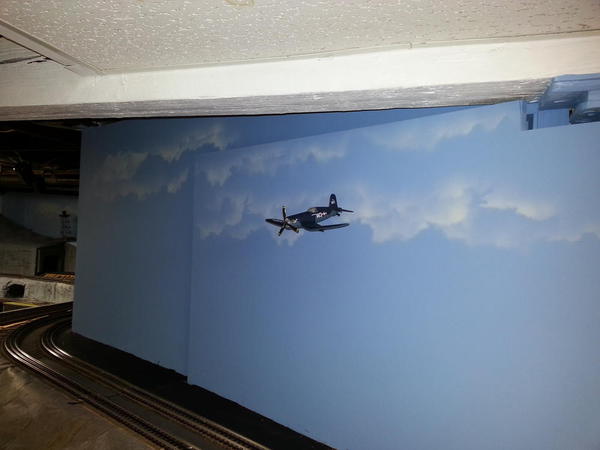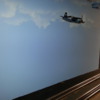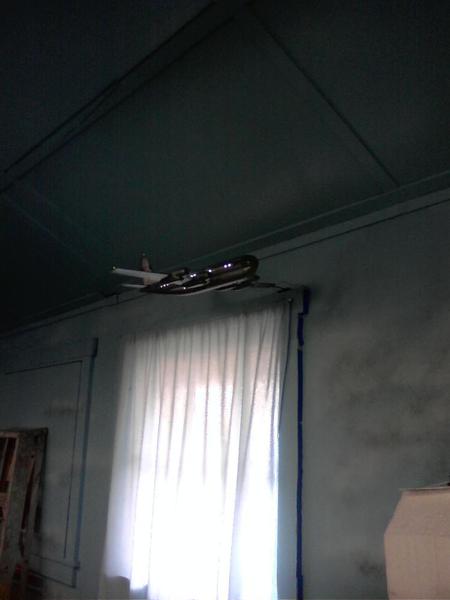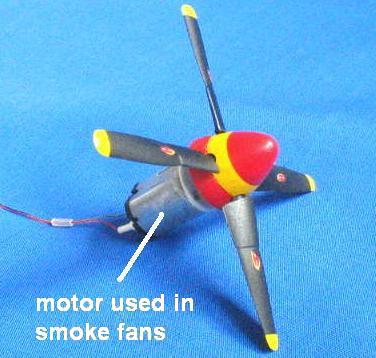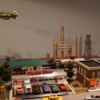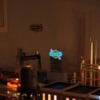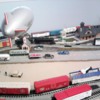We have had these two P51's doing a fly over on our layout for a long time. They've been up there for more than decade and I still like looking at them. I think with the MTH beacon and the mountains they look cool. However, given suggestion of some added LED marker lights would add some effect. Now my kids project.
Replies sorted oldest to newest
Attachments
If you light with LEDs, 32 gauge magnet winding wire should work.
Yes, thanks Jack Pearce. I have a Coast Guard helicopter that is hovering over Seasons Bay that lights particularly well with flashing lights and moving rotor. The photo below is not the best, but if you look beyond the water, you will see the orange helicopter.
Attachments
Attachments
Litegide24 great looking layout. Sorry,I can't help with the lights.
Brad
Len2 beat me to my almost exactly word-for-word reply. Magnet / armature wire. But you'll need LEDs (which will look better, anyway...).
WOW A ZEPLIN!!!!!!!! Choo Choo Kenny![]()
Actually, it is touching. I placed a narrow rod through the wall and into the rear landing gear.
PS: the corsair was made in my hometown by Chance Vought
"How did you get the power to the helicopter?"
I mounted the helicopter on a wood dowel and hid it between some buildings. Once the wires were attached to the dowel, I wrapped it in black tape. Only a small amount of it shows, and only from a limited view.
We have an XB29, a passenger version of a B29 (built by John Pignatelli) mounted above the layout. It's supported by a steel rod through the left wing. Wires run through the wing to light the LED lighting. This is an old photo. We moved the plane closer to the front of the layout and "banked" it to the right.
Attachments
I had a 1:18 scale P-51 Mustang hanging in my toy room years before I ever decided to build a layout in there. I'm now wondering if I should take it down as people might see it in the context of the layout and not an unrelated 'thing in the room'.
I knew a guy who had a decent layout years ago, who modeled a airplane museum and he had several WW2 fighters and bombers parked along a fence line near the tracks, and several had engines running. It really looked good.
I don't model anything that should be moving but isn't. My figures are all in stationery poses and what few cars are on the layout are all parked. I wouldn't model an airplane frozen in place. That said, I model the WW2 era and I could easily model a barage balloon!
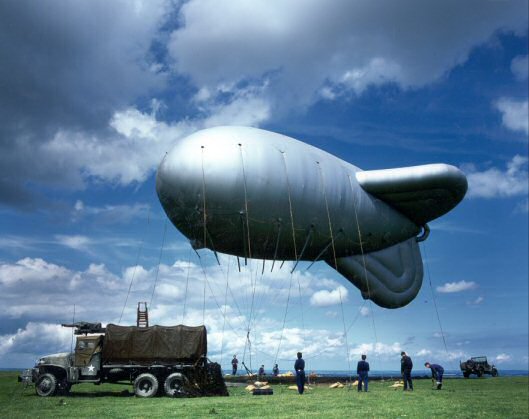
Don't miss this, the best representation of an airport ever done on any model RR layout, in HO, with airplanes actually taking off and landing!
Magnet or armature wire is very very thin. You wanted a method to suspend the planes yet run electricity to them. Use one wire for pos, one for neg, and a third for the tail (unconnected unless you wanted to be able to turn a landing light on or off separate from the nav/position lights).
If you light with LEDs, 32 gauge magnet winding wire should work.
What he's referring to is VERY THIN wire - 32 gauge. Since the only current draw will be a couple of LED's you can use very small wire for this. 32-gauge wire is only .0080 in diameter, which is probably smaller than your fishing line!
In free air, 32 gauge wire can handle 530 milliamps of current (just over half an amp.) Three or four LED's will draw about 1/4 of that.
Attachments
MANY years ago, I saw a guy who had some manner of track system run by a computer that had slots in the ceiling of two rooms. He pushed a button and a MIG 21 model suspended from lines running to whatever prime mover was controlling it from the attic came around a corner in the wall, immediately chased by an F-4. They zipped through both rooms and a moment later came back. No sounds, and he said he was trying to figure out how to do that, as well as having a missile comming out of the Phantom somehow for it to 'shoot down' the MIG.
The guy wouldn't go into how he'd done it, but the planes even banked correctly as they turned. He said he sometimes swapped the planes for a ME-109 being chased by a Spitfire.
To this day, I wish I'd known how he did it. Over the years I've tried looking it up but have never found anything. For the life of me, I can't recall the guy's name but he lived outside of Atlanta, I think in the Stone Mountain area.
Those layouts with planes over head look great.
Have the odd item hanging over mine as well a must for a good layout.
At the Christmas model train display I set up I hung a thing I constructed from the ceiling with a bbq rotisory motor attached that turned a rod on a bearing below it, from here I had arms sticking out and 6 planes, santa attached on long thin thread hanging below.
It turned slowly with the planes flying over the layout.
I would think that using conductive wire instead of thread a + one one side of plane wing and - on other plane wing and some inner wiring to lights on the planes might work very well.
There are some really tiny LED bulbs that are small enough they might fit in many planes or copters for a lit flying item on the layout.
Can (6) led's for both planes be run 25-30 feet (then switched) without voltage drop of sorts?
So-called "magnet wire" has a thin, generally enamel, coating that insulates the underlying copper wire. This allows you to wrap it over itself as done in coils or motor armatures without shorting overlapping turns. Magnet wire can be difficult to buy in small quantity (a few feet is apparently all you need) as it generally comes in 1/4 lb spools (and up) which can be thousands of feet for small gauges.
I don't think you need magnet wire if you're only running 2 or 3 wires from the ceiling as surely you can keep the wires physicially (and hence electrically) separated at the central mounting point. I'd think you'd run thicker wire, say 24 gauge or whatever you have) from your AIU up to the ceiling mounting point and then use the thinner wire for the last foot or two. That way you don't have to worry about voltage drop...albeit a pair of 32 gauge wire at 30 feet is only about 10 ohms (inconsequential for powering a handful of LEDs).
But if you go with magnet wire and don't have a source for small quantities, take a look at craft stores for something called "Artistic Wire" or "Beading Wire". This is essentially magnet wire but comes in a variety of gauges, colors, and in small spools. For example, if your ceiling or backdrop is painted sky blue, they have shades of blue which might better disguise the tethers. Most magnet wire sold for electrical applications is brownish-orange, or green, or red which may not blend well.
It comes down to how much time and effort you want to put into it. I'm not as familiar with the pre-assembled diecast Mustangs but I know that some can be dis-assembled to some degree to gain access to the innards for LED lighting retro-fit. I've also seen diecast planes that can be dis-assembled far enough to retro-fit small electric motors to spin the props. I am quite familiar with plastic model kits in 1/48 scale for the Mustang and here are some LED lighting ideas that might give you some ideas on how to tackle your project.
At scale, the P51 wing tips are quite thin to install LEDs so as shown above I generally installed the LEDs further back and use thin acrylic fiber-optic to bring the light to the tips. The photo also shows the machine guns which I use flickering LEDs to model strafing. Here's a video of the strafing; synchronized sound is difficult to implement so I won't get into that just now:
You can model the white tail Nav light using the same fiber optic concept since it is quite thin back there so even the smallest LEDs are too big to scale. The landing lighting in the wheel well is fairly easy to do since there's a reasonable amount of space to fit a white LED.
For added interest, there are the IFF lights which were set to the colors of the day for Identification-Friend-Foe in some theaters of operation. These are fairly easy to model using surface-mounted LEDs.
It is said that in the European theater, for pre-dawn takeoff, the blue exhaust flicker from the exhaust ports were used for formation lighting. If you can access the ports you can make a pretty cool effect as shown in this video. In this case the modeling shows the pilot adjusting the fuel-mix to get the blue-glow rather than orange. Like the machine-gun, this uses flickering LEDs.
And if you can access the nacelle in your diecast, just about any tiny motor can spin the prop. I generally use the same 12mm diameter motor used in train smoke fans. The hardest part of spinning the prop is drilling a centered hole so the prop spins "true" without visible wobble.
Attachments
Attachments
I have two blimps "flying" over my layout. Both are die-cast and held up with fishing line. (I can't remember the strength of the line, but it was pretty thin and testing to something quite a few times heavier than the die-cast blimp.)
The construction and seams of the blimps I have do not lend themselves to installing lighting in them without the risk of damaging a fin, stabilizer or gondola. The "nighttime" effect of the layout's lighting tends to cast them in "light" when I turn off the lights.
Here's the Goodyear blimp "flying" over the refinery area of my layout during the "day".
Here's the same scene at "night".
You can see the US Navy blimp "flying" in the upper rear area of this photo from last December.
This photo is about 6 years old and taken while I was standing on a stool. It gives a good view of how I used "slider tubes" for a little girl's necklace parts to make the attachment points through which I ran the fishing line. I bought the "slider tubes" at Michaels' craft shop. (A tip of the hat to Dennis Brennan who gave me the idea when I was asking for some "attachment point" ideas years ago.) This photo also shows why installing lighting would, in my estimation, be difficult with this die-cast model and its location.
Attachments
Was down at the club today and got a photo of how the plane is positioned now as opposed to the old photo in my previous post.
Attachments
Just for clarification it is not a B-29. it is a C-97 (military) or KC-97 (military tanker) or Boeing 337 (civilian). It is a development of the B-50, which in itself is a development of the B-29.







